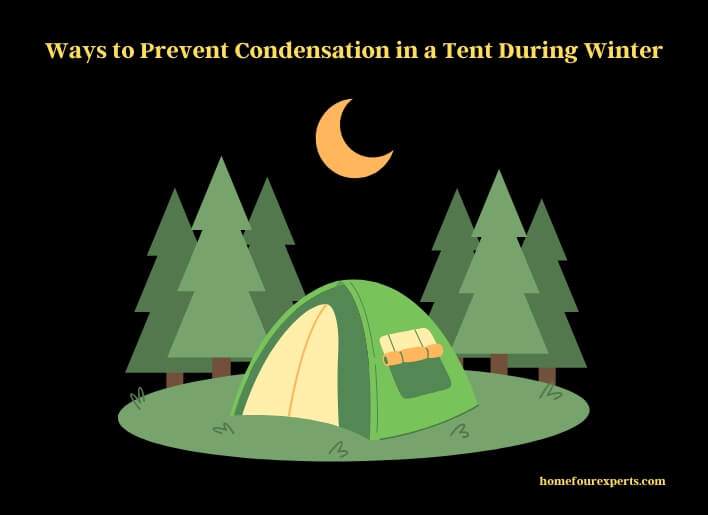We love to watch and get wet in the rain when it rains outside in summer. But in winter, a tiny little droplet of water caused by condensation is equally annoying. It makes you wet, ruins camping supplies, gears, other goods, and most of all, ruins the camping mood.
It won’t happen if you learn ways to prevent condensation. Why does it happen in winter, what is the science behind condensation, how to prevent it, and how to stay warm without creating or fueling condensation? All are documented here so that you can apply all these in your next camping to make it more enjoyable

Why is Condensation Bad in Winter?
Do you prefer to wear wet clothes during winter? Then you know why condensation is bad in winter. The built-up water droplets drip onto the camp gears, goods, sleeping bags, clothes, blankets, and everything else. In the winter season, wet items are the last thing we want. That is why the condensation of camping tents is more alarming during winter compared to summer.
What Are Some Common Causes of Condensation in Tents
Common causes of condensation in tents include:
- Breathing: The moisture from breathing and sweating inside the tent can condense on the walls and roof.
- Temperature difference: When the temperature inside the tent is warmer than the outside air, condensation can form on the walls and roof.
- Humidity: High humidity levels can also contribute to condensation inside the tent.
- Poor ventilation: A lack of proper ventilation can trap moisture inside the tent, leading to condensation.
- Pitch location: Pitching a tent in a shaded or damp area can also increase the likelihood of condensation forming inside the tent.
- Quality of tent material: The quality and breathability of the tent fabric can also play a role in condensation formation.
Why does Condensation Happen in Winter Camp Tents?
Before discussing the ways to prevent condensation in tents during winter, let’s learn about why this even happens. If I explain elaborately the reason behind winter condensation, it will be easier for you to understand the ways to prevent it.
We all know the three forms of water: liquid, ice, and gas or steam. Condensation happens when the gas form of water, for example, moisture in the air or steam from boiling water comes to contact with a colder surface. The gas form of water has a temperature of 100 degrees centigrade. Any surface colder than that temperature will make the gas change its form into a liquid.
So this is why condensation happens mostly on tent walls. When we breathe or cook inside a tent, moisture builds up inside the tent. If the weather is colder than the inner portion of the tent, the moisture in the interior builds up as water droplets onto the walls of the tent and causes condensation.
Likewise, condensation also happens in summer if the camp tent is not ventilated. The interior of the tent becomes hot compared to the exterior and water builds up to the tent’s surface.
6 Clever Ways to Prevent Condensation
We have learned about the scientific explanation of condensation. But how to prevent it? Here are some ways to prevent it during winter.
1. Select Camp Site Wisely
Your first priority for choosing a camp location should be a cool and dry place. If the ground is already wet, the tent will more likely get wet from the moisture on the floor and initiate condensation.
If possible, set the camp on a high base. Use a tarp under the tent and also use camp carpenters and rugs on the floor. Camping under a tree also helps to keep the tent cool.
2. Breathable Tent
You must select a breathable tent no matter what the season is. A breathable and waterproof tent is the key here. Some tents are also advertised as condensation-free tents. Those are expensive but worth the price. You can cook, sleep, and do all the things inside the tent that we prohibit to prevent condensation.
3. Ventilation
The moisture build-up is the main culprit to cause condensation. So, what to do? We can stop cooking inside the tent, but can we stop breathing? We can’t. So, the solution to this problem is to air out the tent from time to time.
Open all the zippers of your tent to vent out the moisture built up. Some keep open a tiny hole to vent the tent. If that is not effective, then try keeping down the rainfly, sunshade, and air out the tent all the way.
4. Using Dehumidifier
If it is snowing outside, then venting out of the tent will not be the best idea. In that case, use a dehumidifier. Its electric, it prevents moisture build-up without sacrificing the warmth inside the tent.
5. Keeping Snow, Water, and Vapor Out
Don’t bring snow inside the tent. If you go out, then brush off all the snowflakes from your hat, clothes, booths, and gear before letting those in the tent. Also, don’t cook, wash, take a bath or dry out clothes and sleeping bags inside the tent. Vapors and streams from all those activities and items will be trapped in the tent and enhance the condensation level considerably.
6. Fix the Leaking Tent
A leaking tent will speed up the condensation process. Besides, it will be hard to distinguish if the tent is leaking, condensation, or both. If the tent wall, floor, or roof has a wet patch, then it is possibly leaking. It happens when the waterproof layer of the tent thins out or wears off. The problem is if your tent forms a leak, then it will attract more moisture towards it and spread out the leak, and also cause condensation inside.
To prevent this, always check the tent before packing for camping. Use waterproof spray or scotch guard, test the tent by spraying water, sun dry it, and then pack it for camping.
How Can You Remove Condensation From a Tent?
There are a few ways to remove condensation from a tent:
- Increase ventilation: Open the tent’s windows and vents to allow more air to circulate inside. This will help to reduce the humidity level and prevent condensation from forming.
- Use a moisture-absorbing product: You can use a moisture-absorbing product such as a moisture absorber bag or silica gel packets to absorb excess moisture from the air inside the tent.
- Wipe down the tent: Use a clean, dry cloth or a microfiber towel to wipe down the tent’s walls and ceiling. This will remove any visible condensation and prevent it from dripping onto your gear.
- Keep gear dry: Keep your gear dry by using waterproof bags or a dry bag, it will help to reduce the amount of moisture inside the tent.
- Pitch your tent in the right spot: Pitch your tent in a well-ventilated spot, out of direct sunlight, and avoid low-lying areas where moisture can collect.
- Invest in a dehumidifier: A portable dehumidifier can help to remove excess moisture from the air inside your tent.
It is important to note that, it is normal for condensation to form inside a tent, especially in humid environments. With proper care and maintenance, you can reduce the amount of condensation and keep your tent comfortable and dry.
FAQs
How Do You Survive in a Tent in the Winter?
As we have been discouraged to burn anything inside the tent, what will be the method to stay alive in the tent when the weather outside is unforgiving? There are many ways you can cope in that situation. Wear thermals, layer up your clothes on it, use two sleeping pads, use a thermal blanket inside the sleeping bag, throw a thermal blanket on the tent roof, use a small tent, use an electric heater, tent with a small group and huddle up inside the tent, eat and drink warm food and liquid and so on. Surviving bad weather is about patience.
How Do You Keep the Inside of a Tent Warm?
Using hot bags, hot water bottles inside the tent helps to keep the tent warm without any electric device. But you should use an electric heater if you can. Also, using the burn-out wood and rock from the campfire also works great to heat up the tent without any moisture build-up. You can also set the tent on a dead campfire site to keep it warm all night. If you cook inside the tent to keep it hot, make sure to vent it afterward.
How Do You Insulate a Tent for Winter?
As we have advised layering up with clothes to survive winter camping, the tent also can be layered up to make insulation. You can make snow walls around the tent and spread out snow on the rooftop. Remember, this will work only if you can promise to prevent condensation inside the tent.
Next, you can use carpets, rugs, and anything else to layer up the tent floor from inside. The layering will create more insulation. Finally, you can hand a thermal blanket all around the walls of the tent. Using a small tent will make all these tricks work faster.
Bottom Line
Condensation in a camp tent during winter is unavoidable, but it is preventable. With all these tips, you can guarantee to prevent it in multiple ways, and save your camping gears from getting wet.
Besides, the tips to keep warm without creating condensation in the tent are also covered here. All these ideas together will be useful. If you follow one rule and become reluctant to follow another, then there will be no use to follow any rule. To minimize condensation, one should follow all the ideas we have shared.
You might also like:
About This Writer

Guys, I am Camila Avery and I love to help my mom to do indoor & outdoor activities. As a lady, I have passed my time on gardening, home improvement, and personal or self-care. I have acquired some degrees in outdoor recreation, beauty, and hair care. It is not easy to work with top-level professional beauty experts. But, I got that opportunity and experimented with different hair extensions, hair colors, and cuts.